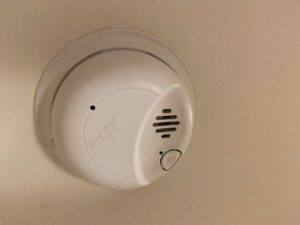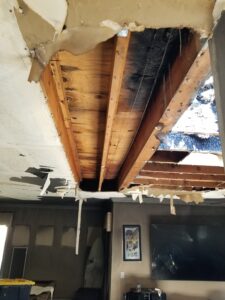 If your life or a loved one’s life depended on it, can you tell the difference between the sounds a home smoke alarm makes when there’s a real fire versus a low battery notification? Are you sure? Your lives might depend on the right answer.
If your life or a loved one’s life depended on it, can you tell the difference between the sounds a home smoke alarm makes when there’s a real fire versus a low battery notification? Are you sure? Your lives might depend on the right answer.
The National Fire Prevention Association’s (NFPA) members want you to: “Learn the Sounds of Fire Safety”. It’s important that everyone in the home (parents, kids, seniors) learn the different sounds that smoke and carbon monoxide alarms make.
Beep! Beep! Beep!
 According to the NFPA, when an alarm makes noise—a beeping sound or a chirping sound—you must take fast action: A continuous set of three loud beeps—beep, beep, beep—means smoke or fire. Get out now! Call 9-1-1, and stay out! A single chirp every 30 or 60 seconds means the battery is low and must be replaced.
According to the NFPA, when an alarm makes noise—a beeping sound or a chirping sound—you must take fast action: A continuous set of three loud beeps—beep, beep, beep—means smoke or fire. Get out now! Call 9-1-1, and stay out! A single chirp every 30 or 60 seconds means the battery is low and must be replaced.
To learn the sounds of your smoke and carbon monoxide (CO) alarms, check the maker’s instructions that came in the box or search the brand and model online. In an emergency, be ready to help all family members, especially those with hearing or vision loss or mobility issues.
At Helfrich Associates, we’re licensed engineers with extensive experience in post fire event home restoration. We’ve heard terrifying stories with close-calls and tragedies too. That’s why this month’s maintenance calendar includes changing out smoke and CO alarm batteries.
Smoke Detector Replacement?
 Did you know that smoke alarms must be replaced after 10 years? Their electronic sensors degrade with time and become ineffective. Chirping that continues after the battery has been replaced means the alarm is at the end of its life and the unit must be replaced.
Did you know that smoke alarms must be replaced after 10 years? Their electronic sensors degrade with time and become ineffective. Chirping that continues after the battery has been replaced means the alarm is at the end of its life and the unit must be replaced.
The NFPA’s smoke alarm report says that working smoke alarms in the home reduce the risk of dying in a reported fire by more than half (55 percent).Three out of five home fire deaths occur in homes where there are no smoke alarms or have smoke alarms that weren’t functional (think 10-years old or older). That total includes homes with disconnected alarms or those with dead batteries.
Home Fire Sprinklers
Nevertheless, the NFPA also says that more than 2,500 people die in home fires each year. If a home fire occurs, the risk of dying decreases by about 80 percent when the home is also equipped with a fire sprinkler system. Sprinklers only activate with high heat—so don’t worry about cooking odors or other vapors and tobacco smoke.
One word of caution, however, home sprinkler systems require maintenance too. If you live in our Southern California mountains where winter temperatures drop below freezing, then you’ll want to winterize them to prevent damage. Our hard, mineral water also can corrode systems and so you’ll want to flush them periodically per the system installer’s instructions.
Fire Damage Plans
 If the worst happens and there’s a fire at your home, the Helfrich-Associates, Inc., team will mobilize quickly to provide the repair plans, structural specifications, and building permit assistance that you and your repair contractor will need to get your house back to its pre-fire condition. Our services include an initial assessment to determine the nature and extent of damage, and then preparation of plans to address the damage. Simple fire repair projects typically consist of removing and replacing the fire damaged members. More complex fire damage plans include temporary shoring plans and targeted demolition plans to minimize collateral damage that is needed to access the fire damage elements.
If the worst happens and there’s a fire at your home, the Helfrich-Associates, Inc., team will mobilize quickly to provide the repair plans, structural specifications, and building permit assistance that you and your repair contractor will need to get your house back to its pre-fire condition. Our services include an initial assessment to determine the nature and extent of damage, and then preparation of plans to address the damage. Simple fire repair projects typically consist of removing and replacing the fire damaged members. More complex fire damage plans include temporary shoring plans and targeted demolition plans to minimize collateral damage that is needed to access the fire damage elements.
 For example, we often do not need to remove an undamaged second floor space if the first floor space has been structurally damaged. In that situation, we will prepare shoring plan to temporarily support the second floor while repairs to the first floor are made. In addition to structural plans, the Helfrich-Associates team provides electrical, mechanical, and plumbing plans to restore those elements of the building.
For example, we often do not need to remove an undamaged second floor space if the first floor space has been structurally damaged. In that situation, we will prepare shoring plan to temporarily support the second floor while repairs to the first floor are made. In addition to structural plans, the Helfrich-Associates team provides electrical, mechanical, and plumbing plans to restore those elements of the building.
We also evaluate the Building Code requirements in your area that apply to the fire damage repair. For minor repairs (less than about 10% of the building has been damaged), most building departments allow the damaged portions of the building to be re-built using the same or similar construction. If a majority (50 percent or more) of the building has been damaged by the fire, many building departments will require that the entire building be improved to the current building Code requirements.
Potential Upside?
Extensive plans for large fires typically take several months to prepare and to obtain building permits. We’ll also consult with your home fire insurance carrier. It is also not unusual for clients to use the “opportunity” to update and remodel their homes after a large fire. This additional design process can often add months to a typical re-building schedule.
As we enter into the year-end holiday season, we urge you to be careful and safe with lighting around plants, such as “live” Christmas trees in the home. Be sure to look over those holiday decorations too for frayed unsafe wiring that can lead to electrical shock. If you’re putting up outdoor decorations, please be sure they and their extension cords are approved for outdoor use.
